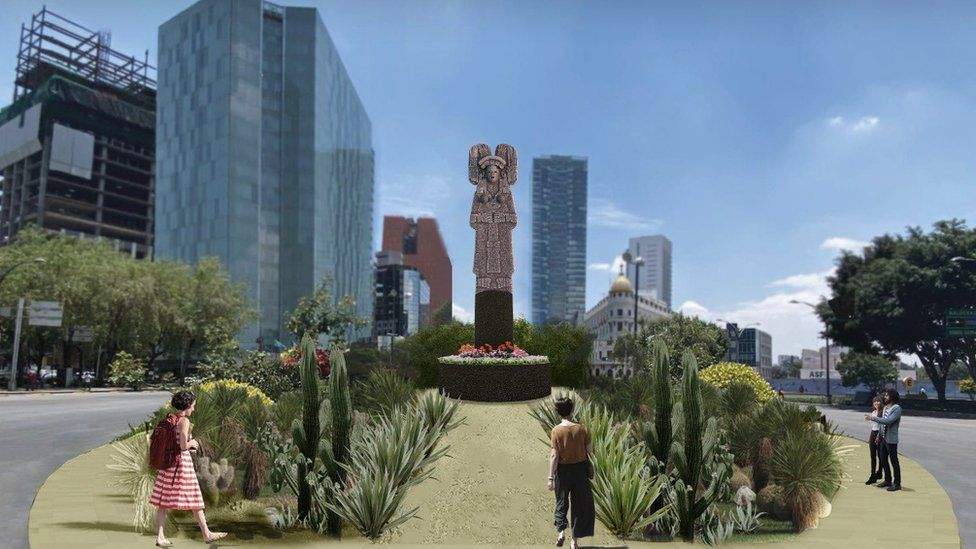In Mexico City, the monument to Christopher Columbus that stands in the center of Paseo de la Reforma (one of the Mexican capital’s busiest avenues), inaugurated in 1877, will be replaced with a statue of a young native. This was determined by the Comité de Monumentos y Obras Artísticas en Espacios Públicos de la Ciudad de México (Comaep). The Columbus monument, a bronze sculpture by French artist Charles Cordier (Cambrai, 1847 - Algiers, 1905), was given to the city by businessman Antonio Escandón, who had commissioned it from Cordier in 1873. In 2020, following protests by the Black Lives Matter movement, the monument was removed, on Oct. 10 (last Sept. 5 the city administration announced that it would be moved to Parque América in the Polanco neighborhood).
Since last October 10, therefore, the plinth has been empty: initially it was planned to replace the Columbus monument with a statue by sculptor Pedro Reyes, titled Tlalli and depicting a woman from the Olmec people (the ancient pre-Columbian civilization that occupied the territories of what is now central Mexico). The hypothesis was later discarded after a petition, signed by 350 people from the world of culture, deemed it inappropriate to entrust the commission to a male artist who does not identify as Native (according to the petition’s promoters, this would have been a contradiction: the hope was therefore that a curatorial committee composed of female artists and curators who identify as members of Native peoples would be formed to choose a female and Native artist). The idea, from the beginning, was precisely to erect a monument to Native women.
The decision was announced yesterday by the mayor of Mexico City, Claudia Sheinbaum: a reproduction of the “Girl of Amajac,” a sculpture discovered in January 2021 (Amajac is the village, near Veracruz, where it was found), and currently kept at the Museo Nacional de Antropología, will be installed in place of the Columbus monument. It is a sculpture depicting a native woman, probably from the Huaxtechi people, a pre-Columbian civilization in northeastern Mexico subject to Aztec rule. From the way she is depicted, she is supposed to be an elite woman of the Huaxteco people, and she also has features that link her to the goddess Tlazoltéotl. The stone original (which may date back to the 15th century) is about two meters in height, and the replica that will be installed in Paseo de la Reforma will be three times larger, thus coming to be taller than the Columbus monument itself.
The operation is part of a process of cultural decolonization initiated by Mexico City and currently focused precisely on Paseo de la Reforma: the new monument will be, in Mayor Sheinbaum’s intentions, an acknowledgement of indigenous women, to remember also the persecution they suffered in colonial times. “Giving this special space to indigenous women has a very strong significance for our city,” said Sheinbaum: “It is an acknowledgement of how our city and our country was unfortunately part of a history of classism and racism in colonial times.”
“It was not an imposition,” said Ricardo Ortiz Armas, citizens’ representative in Comaep. “It was an issue on which we deliberated, taking into account aspects of society’s sensitivities,” he said. “We believe that this decision completely saves this new image, which by the way is aesthetically very beautiful and means a lot to all Mexicans.” For the time being, Mexico City’s other Columbus monument, the one located on Avenida Buenavista and unveiled in 1892, on the 400th anniversary of the discovery of America, remains in place: unlike the removed monument, however, it is a sculpture entirely conceived and created in Mexico, being the work of Mexican sculptor José Manuel Villalpando.
Pictured is a rendering of the new monument.
 |
| Mexico City, Columbus monument will be replaced with a monument to native women |
Warning: the translation into English of the original Italian article was created using automatic tools. We undertake to review all articles, but we do not guarantee the total absence of inaccuracies in the translation due to the program. You can find the original by clicking on the ITA button. If you find any mistake,please contact us.